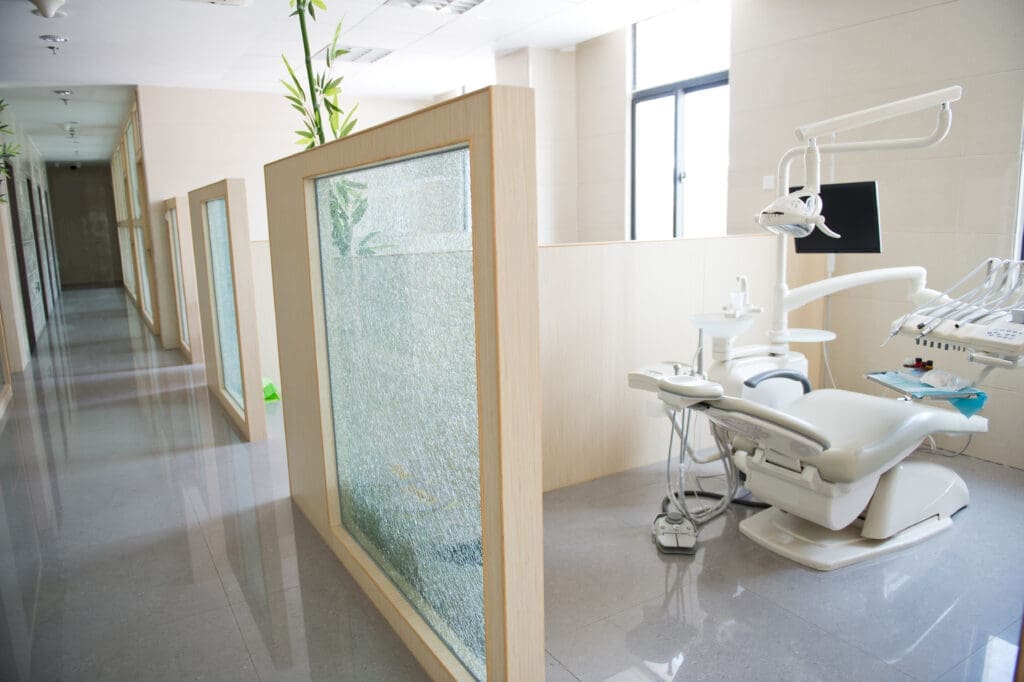 Q: How do I know if I’m “maxed out” in my current practice’s space? I’d love more space, but I’m not sure if it’s worth the extra expense.
Q: How do I know if I’m “maxed out” in my current practice’s space? I’d love more space, but I’m not sure if it’s worth the extra expense.
A: Great question! In recent years, I’ve seen larger practices (from a space perspective) become more the norm.
Whereas 3-5 ops (including hygiene) used to be pretty normal and 6 was “big,” the new buildouts I’m seeing run a bit bigger nowadays, with 9-12 chairs not all that uncommon anymore.
And while I love the idea of dreaming big and having a nice spacious facility, I’m also not a fan of spending large amounts of money unnecessarily.
If you want to be able to stretch your arms out and you can afford the expense, then having additional chairs to support future expansion is your prerogative. But if you’re expecting “more chairs” to immediately translate into increased production/revenues, they don’t necessarily correlate. Before adding chairs or more space, you need to ensure you’re fully maximizing current resources.
To be honest, I would say that in over 90% of cases I see, the number of chairs is not what is limiting practice production.
(Related: If You Build it They May Not Come — 4 Things to Consider Before Expanding Your Practice)
And to take on an expansion project or add an associate before you’re ready can be a disaster. Your overhead goes up, but production stays the same, and it only adds stress.
So, before you fall in love with the idea of taking on more ops, let’s look at potential inefficiencies you could clean up first.
Things to look at before taking on extra ops:
 How much are you producing per operatory?
How much are you producing per operatory?
An efficient dental office doing every day, run-of-the-mill general dentistry should be able to produce $50,000 per operatory monthly.
And yes, this includes hygiene chairs. Now, the hygienists themselves may not be doing 50K/each, but their chairs factor into the equation, as the increased patient flow from a hygiene chair should translate into more production on the doctor’s schedule.
So, if you have 4 ops, you should be producing/collecting somewhere in the ballpark of $200,000/month before you’re truly maxed out.
And if you do specialty procedures (implants, ortho, full-mouth reconstructions, surgery, etc), then that number can be much higher.
So if you’re doing $150,000 out of 6 ops, you can add ops if you want, but don’t expect it to raise your production. There are other problems/inefficiencies holding you back that have nothing to do with the number of chairs.
(Related: 5 Clever Ways to Make Your Practice’s Production More Consistent)
Is the doctor’s time being utilized as efficiently as possible?
Obviously, some doctors work faster than others and that’s fine. I’m not trying to rush you clinically.
But regardless of clinical speed, I’ve found that the average dental office could produce at least 40% more in the same time—just by scheduling more efficiently.
All the details of the MGE Scheduling System are laid out at the MGE Scheduling for Production Seminar and on the Scheduling Coordinator Training Course on our on-demand video training platform, DDS Success. I highly suggest checking those out.
A couple of the keys are:
- Having an assistant in each operatory (excluding hygiene). If you don’t already have this, then hiring an additional RDA is most likely cheaper and more effective than adding more ops.
- Being precise with procedure times, including clearly delineating between doctor time vs. assistant time, so the doctor can just sit down, perform the procedure, and then walk into the next room where the patient is already prepped—with no wasted time.
- Eliminating cancelations and no-shows.
- Filling up chair time with the types of procedures you want in those times—and not just putting patients wherever there’s an opening or filling up empty space with low-value or zero-value appointments just for the sake of filling a chair.
Are your RDAs (and particularly EFDAs) doing everything they’re allowed to do in your state?
If you’re trying to improve productivity, then the doctor shouldn’t be doing anything they don’t need to be doing.
If you want to keep doing something yourself because you like doing it, then I won’t stop you.
(Related: 6 “Quick Fixes” For Low Production)
But if you’re doing it yourself because you don’t have an assistant that can do it, you need to further your assistant’s clinical abilities or get assistants that can perform at that level.
And if don’t know exactly what an RDA/EFDA can do in your state, check your state’s bylaws and then have them start doing it.
Are you doing quadrant and full-mouth dentistry—or are you doing bits and pieces according to insurance coverage?
 This is by far the biggest limiting factor on your production. If you’re phasing treatment plans and doing only what the insurance covers—instead of completing the patient’s entire treatment plan in order to get them fully healthy—this is always going to limit your production per operatory.
This is by far the biggest limiting factor on your production. If you’re phasing treatment plans and doing only what the insurance covers—instead of completing the patient’s entire treatment plan in order to get them fully healthy—this is always going to limit your production per operatory.
This is how the average dentist that attends the MGE Communication & Sales Seminars quickly adds an additional $288,000/year to their practice. They didn’t add more ops or see additional new patients—they just started getting patients to accept more ideal treatment plans and complete them now instead of later.
Are you participating in reduced-fee insurance plans (PPOs)?
One way to be over-worked and under-productive is to knock 30-50% off your fees by being in-network.
What you lose from the reduced fees, you have to make up by seeing more patients…and then in order to see more patients, you need to add ops…
It’s a vicious cycle.
If you could just charge your full fee, then you could produce more without needing to run around between ops as much.
But insurance companies have convinced dentists they need to keep participating, otherwise you’ll lose all your patients. This it not necessarily true. You may be surprised how feasible it is to transition out of low-paying PPO plans and retain patients at full fee.
Watch this fantastic video from our COO, Jeff Blumberg, to see how it works.
Summary
Ultimately, if you want lots of ops for your personal preference, and you can afford it, then go ahead.
But if you’re counting on these additional ops to result in higher production, really take a look at the points I mentioned above before you make your decision.
And of course, there are more things that can impact your production levels that I couldn’t fit in this article, and everybody’s situation is different. If you’d like to get a thorough practice assessment and our two cents on what you should do, request a free consultation here.
I hope these tips help. And best of luck to you, whatever you decide!



No Comments
Be the first to start a conversation